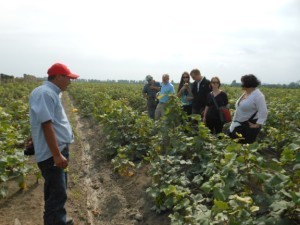
Week 1 – Lima, Peru
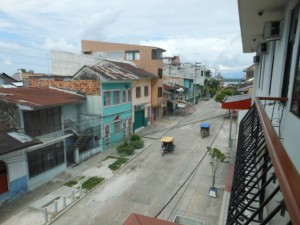 Hola a todos! I have been in Peru since July 14 with NC State’s Genetic Engineering and Society program, to study pest issues in developing nations. Today we arrived in Iquitos, Peru, officially ending week 1 in Lima.
Hola a todos! I have been in Peru since July 14 with NC State’s Genetic Engineering and Society program, to study pest issues in developing nations. Today we arrived in Iquitos, Peru, officially ending week 1 in Lima.
This was a busy, full week of conferences, farm tours, and museum visits. Conferences were spread over Monday, Tuesday, and Thursday at three universities in Lima: San Marcos, Catolíca, and La Molina. The schedule included a diverse mix of presenters representing different universities, different areas of transgenic research (including Peru, Brazil, Panama, and the Key West), and the Peruvian government. These conferences have provided a unique opportunity for not just our group of NC State students, but for all these interested groups. We were able to spend some one-on-one time with Amy Morrison, who is working with the Aedes mosquito in Iquitos, Peru; Nestor Sosa, who is researching dengue and working with Oxitec in Panama; Margareth Capurro, who is researching transgenic mosquitoes in Brazil; and Mike Doyle, who is also researching transgenic mosquitoes in Key West. These conferences provided an opportunity for these scientists, working in the same field, to meet one another and discuss their own technical, social, and regulatory difficulties in each of their areas. Hosting this meet-up in Peru has been significant for a number of reasons, the most significant being the fact that Peru passed a 10 year moratorium on transgenic crops just this past December. These researchers, while working in different areas, have had several overlapping concerns, the biggest being public perception and opinion of their work, governmental regulation, and ethical issues.
A common thread I have noticed in many of these discussions is the difficulty in  navigating boundaries: institutional boundaries, governmental boundaries, economic boundaries, and personal boundaries. We were able to see first hand the differences in economic interests even just within the Cañete valley in Peru, when we visited a corporately owned farm (which produces artichokes for Kirkland), a privately owned farm, and a university research farm. Some researchers presenting at the conferences stressed that no one product would be suitable for all areas. These same researchers (Peruvians themselves) also exhibited much pride in Peru’s biodiversity and diverse landscape. This sense of nationalism extended, from my experience so far, from the scientists who were looking into tools to help preserve this biodiversity, to the citizens who wanted to protect their environment from these transgenic products. What is most interesting to me is discovering how skeptics and proponents (and those who are unsure or have no opinion) share this great sense of pride in their agriculture and environment, but come to seemingly opposing conclusions on how to make “progress.” This, I think, is the role of rhetoric in transgenics.
navigating boundaries: institutional boundaries, governmental boundaries, economic boundaries, and personal boundaries. We were able to see first hand the differences in economic interests even just within the Cañete valley in Peru, when we visited a corporately owned farm (which produces artichokes for Kirkland), a privately owned farm, and a university research farm. Some researchers presenting at the conferences stressed that no one product would be suitable for all areas. These same researchers (Peruvians themselves) also exhibited much pride in Peru’s biodiversity and diverse landscape. This sense of nationalism extended, from my experience so far, from the scientists who were looking into tools to help preserve this biodiversity, to the citizens who wanted to protect their environment from these transgenic products. What is most interesting to me is discovering how skeptics and proponents (and those who are unsure or have no opinion) share this great sense of pride in their agriculture and environment, but come to seemingly opposing conclusions on how to make “progress.” This, I think, is the role of rhetoric in transgenics.
Week 2 – Iquitos, Peru
This has been an interesting first week in Iquitos. We have begun working in 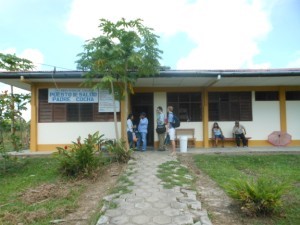 collaboration with Dr. Amy Morrison (UC Davis) who has been in Iquitos studying dengue and Aedes aegypti for 14 years. We were joined in Iquitos by four Peruvian students, three from Lima or surrounding areas, one from Iquitos. There has been some very interesting bilingual communication happening in our activities. I’m very glad their English is much better than my Spanish! I learned some very important differences between “muerta de hambre” and “muerta de hombre,” as well as “café pasado” and “café pescado.” Use Google translate for some nice humor.
collaboration with Dr. Amy Morrison (UC Davis) who has been in Iquitos studying dengue and Aedes aegypti for 14 years. We were joined in Iquitos by four Peruvian students, three from Lima or surrounding areas, one from Iquitos. There has been some very interesting bilingual communication happening in our activities. I’m very glad their English is much better than my Spanish! I learned some very important differences between “muerta de hambre” and “muerta de hombre,” as well as “café pasado” and “café pescado.” Use Google translate for some nice humor.
Friday, Fred honored me with the “award” (an IOU for a pisco sour) of most improved mosquito larvae counter! But there’s lots of room for improvement when the starting point is pitiful; little do my colleagues know that was my strategy all along. We have begun an experiment involving breeding mosquitoes in six different local homes. Amy’s team placed buckets in these homes 6, 5, 4, 3, 2, and 1 week before we arrived, and we placed differing amounts of aegypti larvae in each of these buckets on Wednesday (7/25). Very simply put, our question is how much detritus is needed to maximize aegypti larvae growth, and what amount of larvae is needed to maximize growth? (The idea is that they will not reach adulthood before the experiments ends, so there is no risk of infecting these homes with aegypti. We have kept netting over the buckets to keep the level of detritus under control, and to keep any potential adults from getting out.) The participant homes have been very generous in letting us in their homes every other day for about 1 hour at a time to count larvae. In our evening discussions, Amy has told us that many people in Iquitos are more than generous in allowing her team in their homes in an effort to control dengue (but not all, as I witnessed myself!).
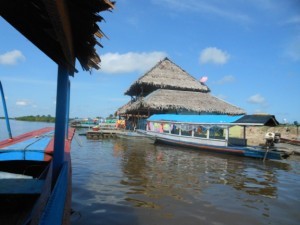 Between larvae counts, we made visits to two health clinics, one urban clinic in Iquitos, the other on a nearby island in the small community of Padre Coche. I was surprised to see that the bigger concerns in both of these clinics seem to be pregnancies, and in the case of the urban clinic, deliveries. In Padre Coche, the doctors we spoke with said that they do not have a problem with dengue fever, but rather malaria. It was a humbling experience to see that each of these clinics only owned one microscope, and the rural clinic had been out of electricity since December. The doctors in the rural clinic also described to us their intense efforts to keep malaria under control in their community, sometimes involving up to three hours of walking in an outbreak.
Between larvae counts, we made visits to two health clinics, one urban clinic in Iquitos, the other on a nearby island in the small community of Padre Coche. I was surprised to see that the bigger concerns in both of these clinics seem to be pregnancies, and in the case of the urban clinic, deliveries. In Padre Coche, the doctors we spoke with said that they do not have a problem with dengue fever, but rather malaria. It was a humbling experience to see that each of these clinics only owned one microscope, and the rural clinic had been out of electricity since December. The doctors in the rural clinic also described to us their intense efforts to keep malaria under control in their community, sometimes involving up to three hours of walking in an outbreak.
In Iquitos, our evenings have been spent listening to lectures on topics like mosquito ecology and dengue epidemiology, but often these lectures spin out into interesting conversations on the social factors related to the disease transmission and the nature of research in Iquitos. Dr. Amy Morrison along with Dr. Tom Scott (UC Davis) is doing some very interesting research on the movement of people in Iquitos and its influence on the transmission of the dengue virus. This work raises questions of how occupation, lifestyle, and possibly gender roles affect dengue transmission. Some of Amy’s work has also shown that most aegypti are born and die in the same home. (Disclaimer: I am not certain how conclusive she is on this research.) This, however, also raises questions of what is a “home.” Based on my very un-empirical observations, residents of Iquitos have a more communal lifestyle than US Americans, where one families’ “home” could extend past the confines of one structure (and even “structure” is loosely defined here). We have also had intense discussion on how to characterize diseases like dengue and malaria – are they 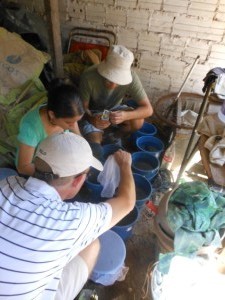 diseases of the “poor,” a “rural” (in the case of malaria) or “urban” disease? I have observed in some of my colleagues some frustration in the difficulty in choosing words to characterize disease and the populations they affect; this was an interesting cross-disciplinary learning experience for me, as I was never shaken by these conversations, but rather felt they were very productive. But the problem that bothered the others still remains – do we settle for language that is “good enough,” or is it possible to find a truly productive and effective means of communicating about this disease to each other and to the affected public? I think we could certainly improve the situation in Iquitos and with the World Health Organization – Amy hopes to use her research to improve health policy decisions in organizations like the WHO, where, as she told me, they promote strategies to control mosquitoes that they know don’t work (for example, some forms of insecticide spraying), but “it keeps the media off the WHO’s back.”
diseases of the “poor,” a “rural” (in the case of malaria) or “urban” disease? I have observed in some of my colleagues some frustration in the difficulty in choosing words to characterize disease and the populations they affect; this was an interesting cross-disciplinary learning experience for me, as I was never shaken by these conversations, but rather felt they were very productive. But the problem that bothered the others still remains – do we settle for language that is “good enough,” or is it possible to find a truly productive and effective means of communicating about this disease to each other and to the affected public? I think we could certainly improve the situation in Iquitos and with the World Health Organization – Amy hopes to use her research to improve health policy decisions in organizations like the WHO, where, as she told me, they promote strategies to control mosquitoes that they know don’t work (for example, some forms of insecticide spraying), but “it keeps the media off the WHO’s back.”
Week 3 – Iquitos, Peru
This final post is coming a bit late due to my high level of frustration with Iquitos’ Internet (or lack thereof). We continued in our last week finalizing our mosquito larvae experiment (results are still being processed), enjoying two free days for the Peruvian independence celebration, and planning and executing individual student projects.
On our free day on Sunday, we went as a large group to a nearby butterfly farm and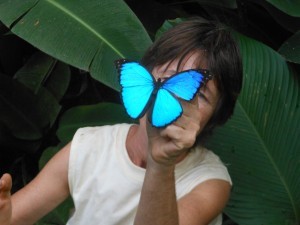 animal orphanage. This farm was owned and managed by a very interesting and eccentric woman originally from Austria. While looking at the butterflies and animals in her care, this woman told us that she often gets “rescue” animals from people whom she described as “stupid people” who buy monkeys or other animals in the market, then bring them to her, saying they “rescued” them. She said, with a heightened inflection in her voice, that her response to them is, “No you didn’t [rescue them], you encouraged [the sellers] to kill the mother for the babies.” She continued, in a mocking tone, that these people’s responses are “Why did you say that? My heart told me to do it.” Then she said “I say, think with your brain.” She spent some time during our tour talking about the political nature of her work. She said she can be fined 50 soles (about 20 US dollars) for each animal she releases without permission from the government. She said she once applied to release two boas, never heard back from Lima, so she “took no answer as a positive” and released the snakes. Later, she says, government officials came to see the snakes and fined her for their release.
animal orphanage. This farm was owned and managed by a very interesting and eccentric woman originally from Austria. While looking at the butterflies and animals in her care, this woman told us that she often gets “rescue” animals from people whom she described as “stupid people” who buy monkeys or other animals in the market, then bring them to her, saying they “rescued” them. She said, with a heightened inflection in her voice, that her response to them is, “No you didn’t [rescue them], you encouraged [the sellers] to kill the mother for the babies.” She continued, in a mocking tone, that these people’s responses are “Why did you say that? My heart told me to do it.” Then she said “I say, think with your brain.” She spent some time during our tour talking about the political nature of her work. She said she can be fined 50 soles (about 20 US dollars) for each animal she releases without permission from the government. She said she once applied to release two boas, never heard back from Lima, so she “took no answer as a positive” and released the snakes. Later, she says, government officials came to see the snakes and fined her for their release.
This experience at the butterfly farm was the first direct experience with human-animal and human-nature relationships in Peru. What was most interesting to me was hearing about the politics and economics of animal releases on this island, and seeing the reactions of others to her presentation about the animals. For example, when she showed us to a cage of small monkeys that she said are known to climb into hummingbird nests and bite the heads off the young, Fred exclaimed, “They’re too cute to do that!” (Personally, I thought they looked completely guilty of such things, since they looked like rats.) I think the emotional connections we have with these animals strongly affects the way we think about these animals and what we consider ethical or unethical to do to them (e.g. Is it appropriate or ethical to genetically modify a mosquito? A rat? Any other animals? Is genetic modification any different from controlled breeding practices?). I was also surprised and interested to hear that she has trouble getting Peruvians interested in butterflies. She said that US Americans have all read The Very Hungry Caterpillar and are more familiar with butterfly ecology than Peruvians. The Peruvian understanding of insect ecology could strongly affect the reception of transgenic mosquitoes!
Getting back to work during the rest of the week, we continued to count larvae and finalize our experiment, and we were also given one day to focus on a project of our own initiative. After visiting the health clinics in week 2, I was interested in looking further into the health system in Iquitos. Gaby (one of the Peruvian students working with us, who also works with Amy Morrison and NAMRU) helped me coordinate my project. We decided to shadow a NAMRU physician, Dr. Isabel, as she visited patient homes who were suspected to have (or were positive for) dengue. These patients were being watched by a NAMRU physician because they were part of Amy Morrison’s current cohort study, where she monitored movement of people and dengue outbreaks in the cohort. We visited three different homes, all within close range of each other, and Gaby graciously served as my translator. In the first home, the dengue patient was not home, but the mother asked Dr. Isabel to look at her son, who she also suspected to have dengue. The mother seemed concerned because so many surrounding homes had dengue. In the second home, a young woman had tested positive for dengue. She explained that her symptoms had gotten so bad a few days earlier that she went to the hospital, where they treated her for a urinary tract infection. I was surprised to hear this error on part of the hospital, because this woman had already tested positive for dengue. Dr. Isabel also seemed surprised at this, and told her patient to not continue treatment for the UT infection, and that this is a common misdiagnosis with people who have dengue. Dr. Isabel also talked to this young woman’s sister briefly, as her mother was concerned she also had dengue; Dr. Isabel decided this was not likely a case since she had not had a fever. Just before leaving, the mother of these two women asked Dr. Isabel if she had a way of performing a procedure to improve her vision. After this last interaction, I wondered if some of these patients participated in Dr. Morrison’s project in order to receive healthcare. (And understandably so, after visiting the clinics in week 2.)
Later in the evening, Dr. Morrison gave a lecture on issues of consent in minimal risk studies (she considers her movement project to be minimal risk). There was much discussion about giving incentives in these research projects – do people participate just for the incentive? In a place where healthcare can be hard to come by, is the guarantee of healthcare too much of an incentive? What is the ethical responsibility of scientists in these situations? The issue of the UT infection misdiagnosis brought me back to another issue – is dengue “legitimate” in the Iquitos health system? What happens rhetorically to give malaria a seemingly higher status over dengue?